Investigation of Flood Hazard Susceptibility Using Various Distance Measures in Technique for Order Preference by Similarity to Ideal Solution
Abstract
:1. Introduction
2. Materials and Methods
2.1. Description of the Study Area
2.2. Methodology
2.3. Data
2.3.1. Flood Inventory Data
2.3.2. Flood Conditioning Factors
2.4. Flood Susceptibility Mapping
2.4.1. Frequency Ratio (FR)
2.4.2. Weights of Evidence (WoEs)
2.4.3. Analytical Hierarchy Process (AHP)
2.4.4. Technique for Order Preference by Similarity to an Ideal Solution (TOPSIS)
- Euclidean Distance
- Manhattan Distance
- Chebyshev Distance
- Jaccard Distance
- Soergel Distance
2.5. Validation of Flood Hazard Susceptibility Maps
3. Results and Discussions
4. Conclusions
Author Contributions
Funding
Institutional Review Board Statement
Informed Consent Statement
Data Availability Statement
Conflicts of Interest
References
- Gupta, V.; Syed, B.; Pathania, A.; Raaj, S.; Nanda, A.; Awasthi, S.; Shukla, D.P. Hydrometeorological analysis of July-2023 floods in Himachal Pradesh, India. Nat. Hazards 2024, 120, 7549–7574. [Google Scholar] [CrossRef]
- Paliaga, G.; Faccini, F.; Luino, F.; Roccati, A.; Turconi, L. A clustering classification of catchment anthropogenic modification and relationships with floods. Sci. Total Environ. 2020, 740, 139915. [Google Scholar] [CrossRef] [PubMed]
- Razavi, S.; Gober, P.; Maier, H.R.; Brouwer, R.; Wheater, H. Anthropocene flooding: Challenges for science and society. Hydrol. Process. 2020, 34, 1996–2000. [Google Scholar] [CrossRef]
- Rawat, A.; Bisht, M.P.S.; Sundriyal, Y.P.; Banerjee, S.; Singh, V. Assessment of soil erosion, flood risk and groundwater potential of Dhanari watershed using remote sensing and geographic information system, district Uttarkashi, Uttarakhand, India. Appl. Water Sci. 2021, 11, 119. [Google Scholar] [CrossRef]
- Intergovernmental Panel on Climate Change (IPCC). Climate Change 2013: The Physical Science Basis-Contribution of Working Group I to the Fifth Assessment Report of the Intergovernmental Panel on Climate Change; Cambridge University Press: Cambridge, UK; New York, NY, USA, 2013. [Google Scholar]
- Giraldo Osorio, J.D.; Gabriela García Galiano, S. Development of a Sub-Pixel Analysis Method Applied to Dynamic Monitoring of Floods. Int. J. Remote Sens. 2012, 33, 2277–2295. [Google Scholar] [CrossRef]
- Trif, S.; Bilașco, Ș.; Petrea, D.; Roșca, S.; Fodorean, I.; Vescan, I. Spatial modeling through GIS analysis of flood risk and related financial vulnerability: Case study: Turcu River, Romania. Appl. Sci. 2023, 13, 9869. [Google Scholar] [CrossRef]
- Hussein, S.; Abdelkareem, M.; Hussein, R.; Askalany, M. Using remote sensing data for predicting potential areas to flash flood hazards and water resources. Remote Sens. Appl. Soc. Environ. 2019, 16, 100254. [Google Scholar] [CrossRef]
- DeVries, B.; Huang, C.; Armston, J.; Huang, W.; Jones, J.W.; Lang, M.W. Rapid and robust monitoring of flood events using Sentinel-1 and Landsat data on the Google Earth Engine. Remote Sens. Environ. 2020, 240, 111664. [Google Scholar] [CrossRef]
- Ouaba, M.; Saidi, M.E.; Alam, M.J.B. Flood modeling through remote sensing datasets such as LPRM soil moisture and GPM-IMERG precipitation: A case study of ungauged basins across Morocco. Earth Sci. Inform. 2023, 16, 653–674. [Google Scholar] [CrossRef]
- Zoka, M.; Psomiadis, E.; Dercas, N. The Complementary Use of Optical and SAR Data in Monitoring Flood Events and Their Effects. Proceedings 2018, 2, 644. [Google Scholar] [CrossRef]
- Sun, Q.; Nazari, R.; Karimi, M.; Rabbani Fahad, M.G.; Peters, R.W. Comprehensive Flood Risk Assessment for Wastewater Treatment Plants under Extreme Storm Events: A Case Study for New York City, United States. Appl. Sci. 2021, 11, 6694. [Google Scholar] [CrossRef]
- Romali, N.S.; Yusop, Z. Flood damage and risk assessment for urban area in Malaysia. Hydrol. Res. 2021, 52, 142–159. [Google Scholar] [CrossRef]
- Monjardin, C.E.F.; Senoro, D.B.; Magbanlac, J.J.M.; de Jesus, K.L.M.; Tabelin, C.B.; Natal, P.M. Geo-accumulation index of Manganese in soils due to flooding in Boac and Mogpog Rivers, Marinduque, Philippines with mining disaster exposure. Appl. Sci. 2022, 12, 3527. [Google Scholar] [CrossRef]
- Dtissibe, F.Y.; Ari, A.A.A.; Titouna, C.; Thiare, O.; Gueroui, A.M. Flood forecasting based on an artificial neural network scheme. Nat. Hazards 2020, 104, 1211–1237. [Google Scholar] [CrossRef]
- Khoirunisa, N.; Ku, C.Y.; Liu, C.Y. A GIS-based artificial neural network model for flood susceptibility assessment. Int. J. Environ. Res. Public Health 2021, 18, 1072. [Google Scholar] [CrossRef] [PubMed]
- Rehman, N.; Zada, U.; Haleem, K. Quantifying the Influences of Land Use and Rainfall Dynamics on Probable Flood Hazard Zoning. NUST J. Eng. Sci. 2023, 16, 54–68. [Google Scholar] [CrossRef]
- Aghenda, M.; Labbaci, A.; Hssaisoune, M.; Bouchaou, L. Flood susceptibility mapping using neural network based models in Morocco: Case of Souss Watershed (No. EGU24-3447). In Proceedings of the EGU General Assembly 2024, Vienna, Austria, 14–19 April 2024. [Google Scholar] [CrossRef]
- Mashaly, J.; Ghoneim, E. Flash Flood Hazard Using Optical, Radar, and Stereo-Pair Derived DEM: Eastern Desert, Egypt. Remote Sens. 2018, 10, 1204. [Google Scholar] [CrossRef]
- Pal, S.; Saha, A.; Gogoi, P.; Saha, S. An Ensemble of J48 Decision Tree with AdaBoost and Bagging for Flood Susceptibility Mapping in the Sundarbans of West Bengal, India. In Geomorphic Risk Reduction Using Geospatial Methods and Tools. Disaster Risk Reduction; Sarkar, R., Saha, S., Adhikari, B.R., Shaw, R., Eds.; Springer: Singapore, 2024; pp. 117–133. [Google Scholar] [CrossRef]
- Akay, H. Flood susceptibility mapping using information fusion paradigm integrated with decision trees. Water Resour. Manage. 2024, 25, 9325–9346. [Google Scholar] [CrossRef]
- Tehrany, M.S.; Kumar, L.; Jebur, M.N.; Shabani, F. Evaluating the application of the statistical index method in flood susceptibility mapping and its comparison with frequency ratio and logistic regression methods. Geomat. Nat. Hazards Risk. 2018, 10, 79–101. [Google Scholar] [CrossRef]
- Xiong, J.; Li, J.; Cheng, W.; Wang, N.; Guo, L. A GIS-based support vector machine model for flash flood vulnerability assessment and mapping in China. ISPRS Int. J. Geo-Inf. 2019, 8, 297. [Google Scholar] [CrossRef]
- Shikhteymour, S.R.; Borji, M.; Bagheri-Gavkosh, M.; Azimi, E.; Collins, T.W. A novel approach for assessing flood risk with machine learning and multi-criteria decision-making methods. Appl. Geogr. 2023, 158, 103035. [Google Scholar] [CrossRef]
- Rahmati, O.; Pourghasemi, H.R.; Zeinivand, H. Flood susceptibility mapping using frequency ratio and weights-of-evidence models in the Golastan Province, Iran. Geocarto Int. 2016, 31, 42–70. [Google Scholar] [CrossRef]
- Liu, J.; Wang, J.; Xiong, J.; Cheng, W.; Li, Y.; Cao, Y.; He, Y.; Duan, Y.; He, W.; Yang, G. Assessment of flood susceptibility mapping using support vector machine, logistic regression and their ensemble techniques in the Belt and Road region. Geocarto Int. 2022, 37, 9817–9846. [Google Scholar] [CrossRef]
- Pusdekar, P.N.; Dudul, S.V. Flood Susceptibility Mapping and Accuracy Assessment of a River Floodplain Using Bivariate Statistical Methods and AHP Approach. In Proceedings of the 2024 International Conference on Emerging Smart Computing and Informatics (ESCI), Pune, India, 5–7 March 2024; pp. 1–8. [Google Scholar] [CrossRef]
- Samanta, S.; Pal, D.K.; Palsamanta, B. Flood susceptibility analysis through remote sensing, GIS and frequency ratio model. Appl. Water Sci. 2018, 8, 66. [Google Scholar] [CrossRef]
- Saha, S.; Sarkar, D.; Mondal, P. Efficiency exploration of frequency ratio, entropy and weights of evidence-information value models in flood vulnerability assessment: A study of raiganj subdivision, Eastern India. Stoch. Environ. Res. Risk Assess. 2022, 36, 1721–1742. [Google Scholar] [CrossRef]
- Castedo, R.; Isidro, M.L.; Moncoulon, D. Geohazards: Risk Assessment, Mitigation and Prevention; MDPI-Multidisciplinary Digital Publishing Institute: Basel, Switzerland, 2023; p. 608. [Google Scholar] [CrossRef]
- Costache, R.; Pham, Q.B.; Arabameri, A.; Diaconu, D.C.; Costache, I.; Crăciun, A.; Ciobotaru, N.; Pandey, M.; Arora, A.; Ali, S.A.; et al. Flash-flood propagation susceptibility estimation using weights of evidence and their novel ensembles with multicriteria decision-making and machine learning. Geocarto Int. 2022, 37, 8361–8393. [Google Scholar] [CrossRef]
- Sarker, S.C.; Monir, M.M.; Islam, M.N. Analyzing Spatiotemporal Changes in Flood Risk Zones to Mitigate Flood Hazards in a Floodplain Area Using a GIS-Based AHP Technique. In Flood Risk Management; Biswas, B., Ghute, B.B., Eds.; Springer: Singapore, 2024; pp. 23–47. [Google Scholar] [CrossRef]
- Tehrany, M.S.; Kumar, L. The application of a Dempster-Shafer-based evidential belief function in flood susceptibility mapping and comparison with frequency ratio and logistic regression methods. Environ. Earth Sci. 2018, 77, 1–24. [Google Scholar] [CrossRef]
- Muthu, K.; Ramamoorthy, S. Evaluation of urban flood susceptibility through integrated Bivariate statistics and Geospatial technology. Environ. Monit. Assess. 2024, 196, 526. [Google Scholar] [CrossRef] [PubMed]
- Cao, Y.; Jia, H.; Xiong, J.; Cheng, W.; Li, K.; Pang, Q.; Yong, Z. Flash flood susceptibility assessment based on geodetector, certainty factor, and logistic regression analyses in Fujian Province, China. ISPRS Int. J. Geo-Inf. 2020, 9, 748. [Google Scholar] [CrossRef]
- Yuan, X.; Liu, C.; Nie, R.; Yang, Z.; Li, W.; Dai, X.; Cheng, J.; Zhang, J.; Ma, L.; Fu, X.; et al. A comparative analysis of certainty factor-based machine learning methods for collapse and landslide susceptibility mapping in Wenchuan County, China. Remote Sens. 2022, 14, 3259. [Google Scholar] [CrossRef]
- Tu, Y.; Zhao, Y.; Dong, R.; Wang, H.; Ma, Q.; He, B.; Liu, C. Study on Risk Assessment of Flash Floods in Hubei Province. Water 2023, 15, 617. [Google Scholar] [CrossRef]
- Bui, D.T.; Khosravi, K.; Shahabi, H.; Daggupati, P.; Adamowski, J.F.; Melesse, A.M.; Pham, B.T.; Pourghasemi, H.R.; Mahmoudi, M.; Bahrami, S.; et al. Flood spatial modeling in northern Iran using remote sensing and gis: A comparison between evidential belief functions and its ensemble with a multivariate logistic regression model. Remote Sens. 2019, 11, 1589. [Google Scholar] [CrossRef]
- Ivan Ulloa, N.; Chiang, S.H.; Yun, S.H. Flood proxy mapping with normalized difference sigma-naught index and Shannon’s entropy. Remote Sens. 2020, 12, 1384. [Google Scholar] [CrossRef]
- Tehrany, M.S.; Pradhan, B.; Jebur, M.N. Flood susceptibility analysis and its verification using a novel ensemble support vector machine and frequency ratio method. Stoch. Environ. Res. Risk Assess. 2015, 29, 1149–1165. [Google Scholar] [CrossRef]
- Tehrany, M.S.; Pradhan, B.; Mansor, S.; Ahmad, N. Flood susceptibility assessment using GIS-based support vector machine model with different kernel types. Catena 2015, 125, 91–101. [Google Scholar] [CrossRef]
- Costache, R.; Bui, D.T. Identification of areas prone to flash-flood phenomena using multiple-criteria decision-making, bivariate statistics, machine learning, and their ensembles. Sci. Total Environ. 2020, 712, 136492. [Google Scholar] [CrossRef] [PubMed]
- Song, J.Y.; Chung, E.S. Robustness, uncertainty and sensitivity analyses of the TOPSIS method for quantitative climate change vulnerability: A case study of flood damage. Water Resour. Manage. 2016, 30, 4751–4771. [Google Scholar] [CrossRef]
- Rane, N.; Achari, A.; Choudhary, S. Multi-Criteria Decision-Making (MCDM) as a powerful tool for sustainable development: Effective applications of AHP, FAHP, TOPSIS, ELECTRE, and VIKOR in sustainability. Int. Res. J. Modern. Eng. Technol. Sci. 2023, 5, 2654–2670. [Google Scholar] [CrossRef]
- Das, S. Geographic information system and AHP-based flood hazard zonation of Vaitarna basin, Maharashtra, India. Arab. J. Geosci. 2018, 11, 576. [Google Scholar] [CrossRef]
- Roy, S.; Bose, A.; Chowdhury, I.R. Flood risk assessment using geospatial data and multi-criteria decision approach: A study from historically active flood-prone region of Himalayan foothill, India. Arab. J. Geosci. 2021, 14, 1–25. [Google Scholar] [CrossRef]
- Dey, H.; Shao, W.; Haque, M.M.; VanDyke, M. Enhancing Flood Risk Analysis in Harris County: Integrating Flood Susceptibility and Social Vulnerability Mapping. J. Geovis. Spat. Anal. 2024, 8, 19. [Google Scholar] [CrossRef]
- Radwan, F.; Alazba, A.A.; Mossad, A. Flood risk assessment and mapping using AHP in arid and semiarid regions. Acta Geophys. 2019, 67, 215–229. [Google Scholar] [CrossRef]
- Teh Noranis, M.A.; Maslina, Z.; Noraini, C.P. Fuzzy AHP in a knowledge-based framework for early flood warning. In Applied Mechanics and Materials; Trans Tech Publications Ltd.: Zurich, Switzerland, 2019; Volume 892, pp. 143–149. [Google Scholar] [CrossRef]
- Hasanloo, M.; Pahlavani, P.; Bigdeli, B. Flood risk zonation using multi-criteria spatial group fuzzy-AHP decision making and fuzzy overlay analysis. Int. Arch. Photogram. Remote Sens. Spat. Inf. Sci. 2019, 42, 455–460. [Google Scholar] [CrossRef]
- Mitra, R.; Saha, P.; Das, J. Assessment of the performance of GISbased analytical hierarchical process (AHP) approach for flood modelling in Uttar Dinajpur district of West Bengal India. Geomat. Nat. Hazards Risk 2022, 13, 2183–2226. [Google Scholar] [CrossRef]
- Das, S.; Gupta, A. Multi-criteria decision based geospatial mapping of flood susceptibility and temporal hydro-geomorphic changes in the Subarnarekha basin, India. Geosci. Front. 2021, 12, 101206. [Google Scholar] [CrossRef]
- Wang, Y.; Hong, H.; Chen, W.; Li, S.; Pamučar, D.; Gigović, L.; Drobnjak, S.; Bui, D.T.; Duan, H. A hybrid GIS multi-criteria decision-making method for flood susceptibility mapping at Shangyou, China. Remote Sens. 2018, 11, 62. [Google Scholar] [CrossRef]
- Pathan, A.I.; Girish Agnihotri, P.; Said, S.; Patel, D. AHP and TOPSIS based flood risk assessment-a case study of the Navsari City, Gujarat, India. Environ. Monit. Assess. 2022, 194, 509. [Google Scholar] [CrossRef] [PubMed]
- Ameri, A.A.; Pourghasemi, H.R.; Cerda, A. Erodibility prioritization of sub-watersheds using morphometric parameters analysis and its mapping: A comparison among TOPSIS, VIKOR, SAW, and CF multi-criteria decision making models. Sci. Total Environ. 2018, 613, 1385–1400. [Google Scholar] [CrossRef]
- Arabameri, A.; Rezaei, K.; Cerdà, A.; Conoscenti, C.; Kalantari, Z. A comparison of statistical methods and multi-criteria decision making to map flood hazard susceptibility in Northern Iran. Sci. Total Environ. 2019, 660, 443–458. [Google Scholar] [CrossRef]
- Khosravi, K.; Shahabi, H.; Pham, B.T.; Adamowski, J.; Shirzadi, A.; Pradhan, B.; Dou, J.; Ly, H.B.; Gróf, G.; Ho, H.L.; et al. Comparative assessment of flood susceptibility modeling using multi-criteria decision-making analysis and machine learning methods. J. Hydrol. 2019, 573, 311–323. [Google Scholar] [CrossRef]
- Li, J. A Flood Season Division Model Considering Uncertainty and New Information Priority. Water Resour. Manage. 2024, 38, 3755–3784. [Google Scholar] [CrossRef]
- Mitra, R.; Das, J. A comparative assessment of flood susceptibility modelling of GIS-based TOPSIS, VIKOR, and EDAS techniques in the Sub-Himalayan foothills region of Eastern India. Environ. Sci. Pollut. Res. 2023, 30, 16036–16067. [Google Scholar] [CrossRef] [PubMed]
- Karami, M.; Abedi Koupai, J.; Gohari, S.A. Integration of SWAT, SDSM, AHP, and TOPSIS to detect flood-prone areas. Nat. Hazards 2024, 120, 6307–6325. [Google Scholar] [CrossRef]
- Nguyen, H.X.; Nguyen, A.T.; Ngo, A.T.; Phan, V.T.; Nguyen, T.D.; Do, V.T.; Dao, D.C.; Dang, D.T.; Nguyen, A.T.; Nguyen, T.K.; et al. A hybrid approach using GIS-based fuzzy AHP–TOPSIS assessing flood hazards along the south-central coast of Vietnam. Appl. Sci. 2020, 10, 7142. [Google Scholar] [CrossRef]
- Akay, H. Flood hazards susceptibility mapping using statistical, fuzzy logic, and MCDM methods. Soft Comput. 2021, 25, 9325–9346. [Google Scholar] [CrossRef]
- Foroozesh, F.; Monavari, S.M.; Salmanmahiny, A.; Robati, M.; Rahimi, R. Assessment of sustainable urban development based on a hybrid decision-making approach: Group fuzzy BWM, AHP, and TOPSIS–GIS. Sustain. Cities Soc. 2022, 76, 103402. [Google Scholar] [CrossRef]
- Anand, A.K.; Pradhan, S.P. Evaluation of bivariate statistical and hybrid models for the preparation of flood hazard susceptibility maps in the Brahmani River Basin, India. Environ. Earth Sci. 2023, 82, 389. [Google Scholar] [CrossRef]
- Delamaire, A.; Juganaru-Mathieu, M.; Beigbeder, M. Correlation between textual similarity and quality of LDA topic model results. In Proceedings of the 2019 13th International Conference on Research Challenges in Information Science (RCIS), Brussels, Belgium, 29–31 May 2019; pp. 1–6. [Google Scholar] [CrossRef]
- Chen, N.; Chen, L.; Tang, C.; Wu, Z.; Chen, A. Disaster risk evaluation using factor analysis: A case study of Chinese regions. Nat. Hazards 2019, 99, 321–335. [Google Scholar] [CrossRef]
- Axelsson, C.; Giove, S.; Soriani, S. Urban Pluvial Flood Management Part 1: Implementing an AHP-TOPSIS Multi-Criteria Decision Analysis Method for Stakeholder Integration in Urban Climate and Storm Water Adaptation. Water 2021, 13, 2422. [Google Scholar] [CrossRef]
- Rani, M.; Kaushal, S. GeoClust: Feature engineering based framework for location-sensitive disaster event detection using AHP-TOPSIS. Expert Syst. Appl. 2022, 210, 118461. [Google Scholar] [CrossRef]
- Kabak, M.; Saglam, F.; Aktaş, A. Usability analysis of different distance measures on TOPSIS. J. Fac. Eng. Archit. Gazi Univ. 2017, 32, 35–43. [Google Scholar] [CrossRef]
- Kwon, N.; Lee, J.; Park, M.; Yoon, I.; Ahn, Y. Performance Evaluation of Distance Measurement Methods for Construction Noise Prediction Using Case-Based Reasoning. Sustainability 2019, 11, 871. [Google Scholar] [CrossRef]
- Costache, R.; Pham, Q.B.; Sharifi, E.; Linh, N.T.T.; Abba, S.I.; Vojtek, M.; Vojteková, J.; Nhi, P.T.T.; Khoi, D.N. Flash-Flood Susceptibility Assessment Using Multi-Criteria Decision Making and Machine Learning Supported by Remote Sensing and GIS Techniques. Remote Sens. 2020, 12, 106. [Google Scholar] [CrossRef]
- Yanmaz, A.M. Applied Water Resources Engineering; Metu Press: Ankara, Türkiye, 2013. [Google Scholar]
- Alvan Romero, N.; Cigna, F.; Tapete, D. ERS-1/2 and Sentinel-1 SAR Data Mining for Flood Hazard and Risk Assessment in Lima, Peru. Appl. Sci. 2020, 10, 6598. [Google Scholar] [CrossRef]
- Avand, M.; Kuriqi, A.; Khazaei, M.; Ghorbanzadeh, O. DEM resolution effects on machine learning performance for flood probability mapping. J. Hydroenviron. Res. 2022, 40, 1–16. [Google Scholar] [CrossRef]
- Saha, T.K.; Pal, S.; Talukdar, S.; Debanshi, S.; Khatun, R.; Singha, P.; Mandal, I. How far spatial resolution affects the ensemble machine learning-based flood susceptibility prediction in data sparse region. J. Environ. Manage. 2021, 297, 113344. [Google Scholar] [CrossRef]
- Pradhan, B.; Hyun-Joo, O.H.; Buchroithner, M. Weights-of-evidence model applied to landslide susceptibility mapping in a tropical hilly area. Geomat. Nat. Hazards Risk 2010, 1, 199–223. [Google Scholar] [CrossRef]
- Adiat, K.A.N.; Nawawi, M.N.M.; Abdullah, K. Assessing the accuracy of GIS-based elementary multi criteria decision analysis as a spatial prediction tool–a case of predicting potential zones of sustainable groundwater resources. J. Hydrol. 2012, 440–441, 75–89. [Google Scholar] [CrossRef]
- Saaty, T.L. The Analytic Hierarchy Process; McGraw-Hill: New York, NY, USA, 1980. [Google Scholar]
- Hwang, C.L.; Yoon, K. Methods for multiple attribute decision making. In Multiple Attribute Decision Making: Methods and Applications a State-of-the-Art Survey; Springer: Berlin/Heidelberg, Germany, 1981; pp. 58–191. Available online: https://link.springer.com/chapter/10.1007/978-3-642-48318-9_3 (accessed on 2 August 2024).
- Chang, C.H.; Lin, J.J.; Lin, J.H.; Chiang, M.C. Domestic open-end equity mutual fund performance evaluation using extended TOPSIS method with different distance approaches. Expert Sys. Appl. 2010, 37, 4642–4649. [Google Scholar] [CrossRef]
- Chetty, M.; Ngom, A.; Ahmad, S. Pattern Recognition in Bioinformatics; Springer: Berlin/Heidelberg, Germany, 2008. [Google Scholar]
- Yoon, S.; Lee, W. Application of true skill statistics as a practical method for quantitatively assessing CLIMEX performance. Ecol. Indic. 2023, 146, 109830. [Google Scholar] [CrossRef]
- Allouche, O.; Tsoar, A.; Kadmon, R. Assessing the accuracy of species distribution models: Prevalence, kappa and the true skill statistic (TSS). J. Appl. Ecol. 2006, 43, 1223–1232. [Google Scholar] [CrossRef]
- Yesilnacar, E.; Topal, T. Landslide susceptibility mapping: A comparison of logistic regression and neural networks methods in a medium scale study, Hendek region (Turkey). Eng. Geol. 2005, 79, 251–266. [Google Scholar] [CrossRef]
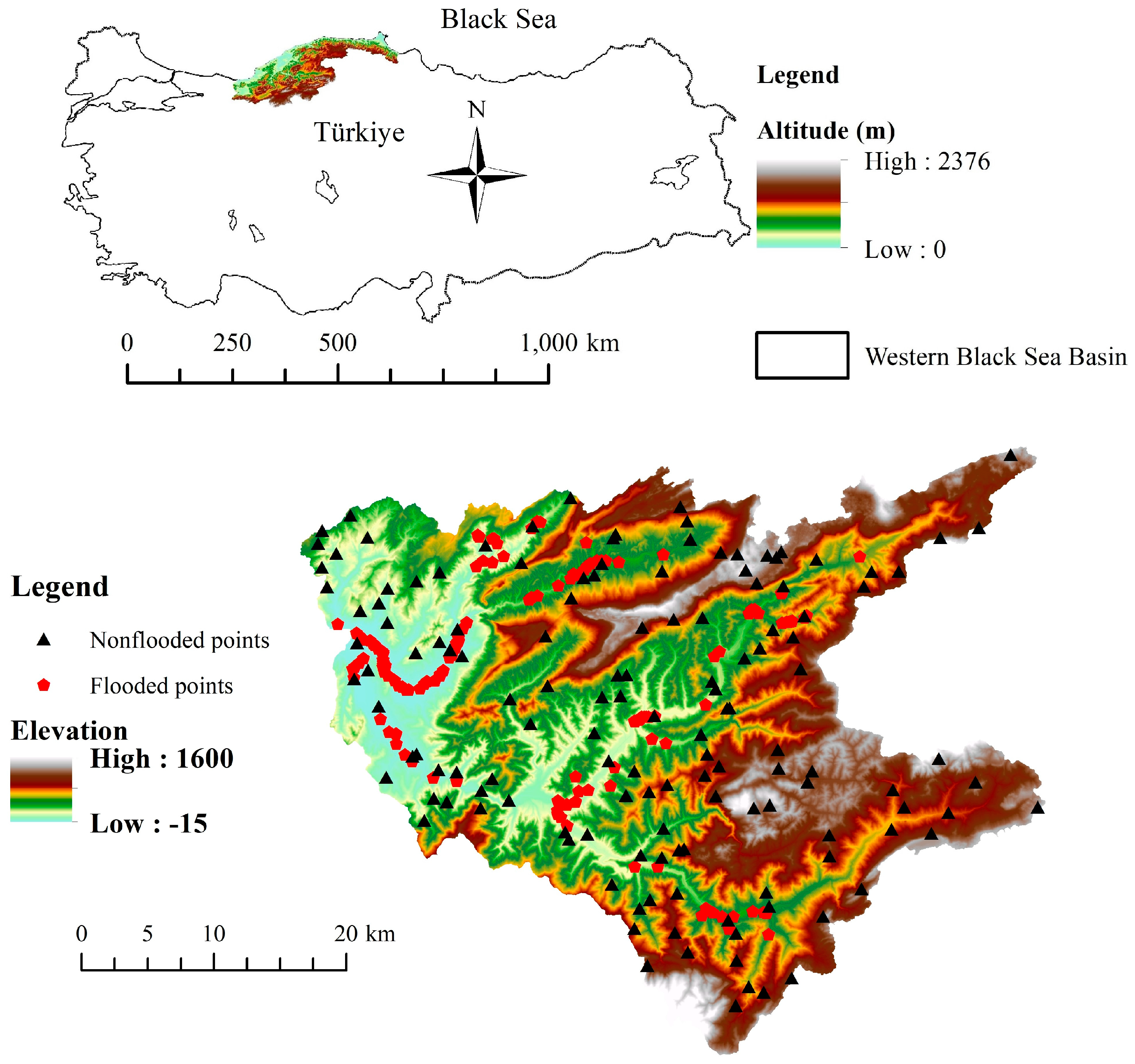


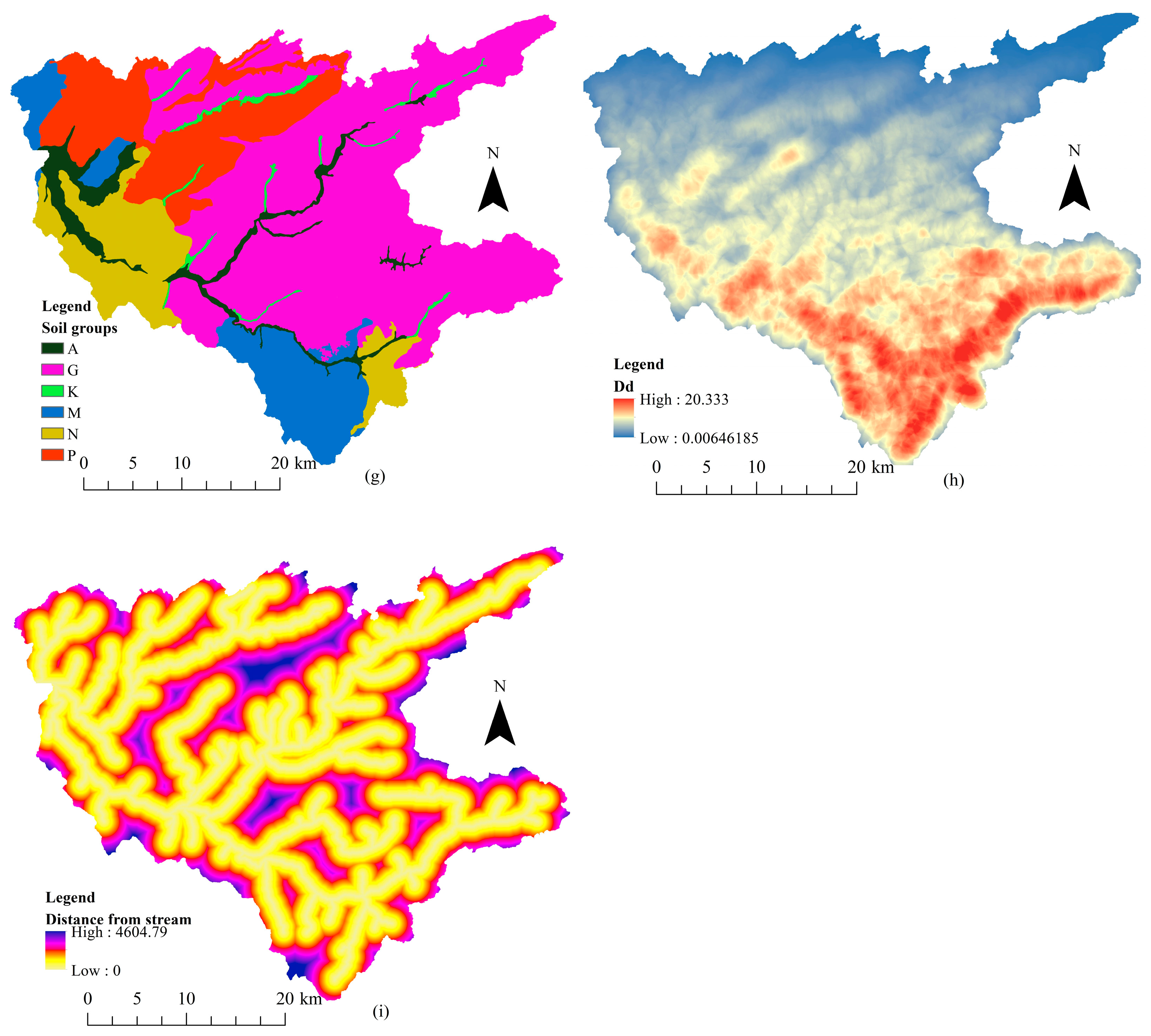
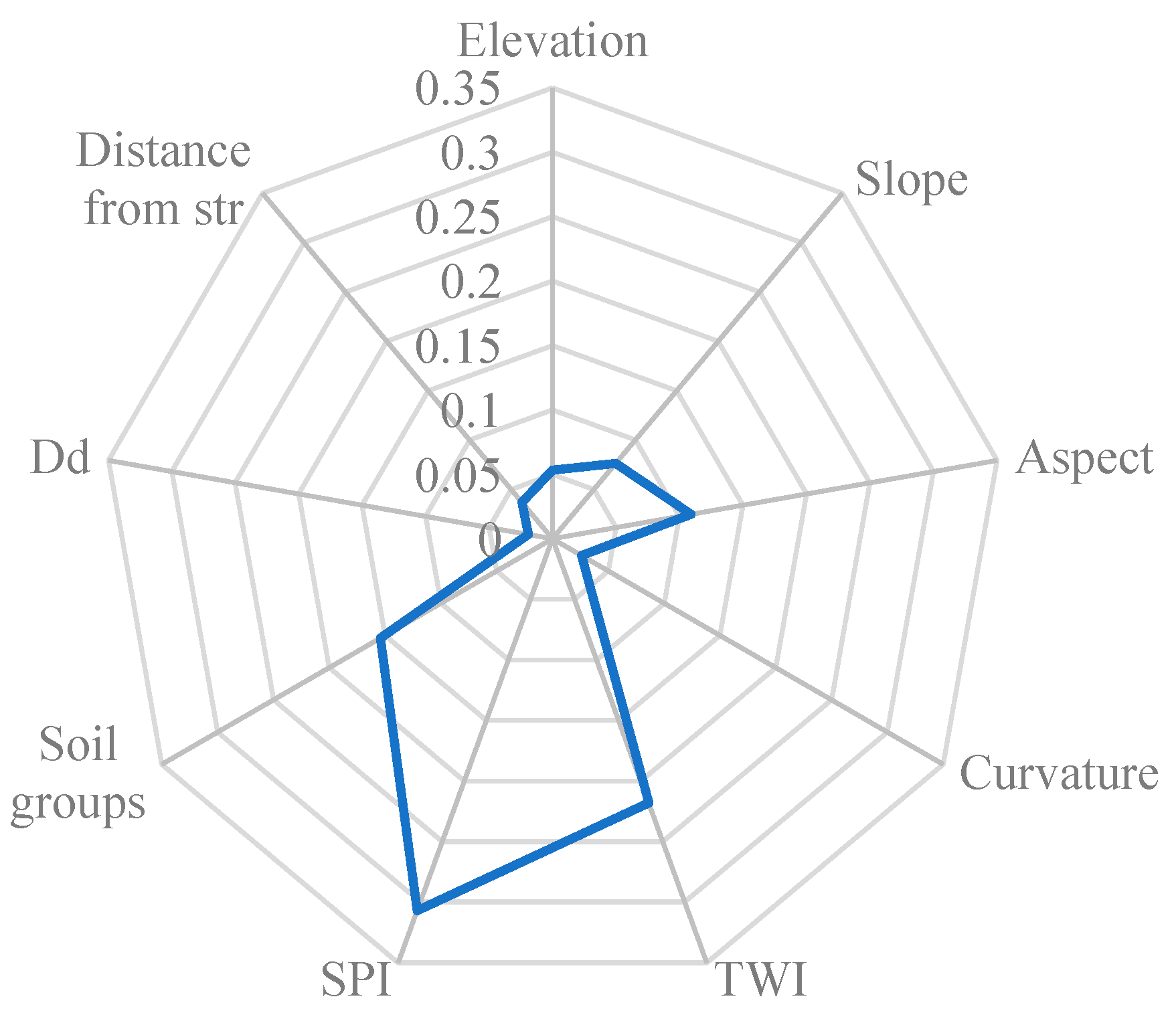

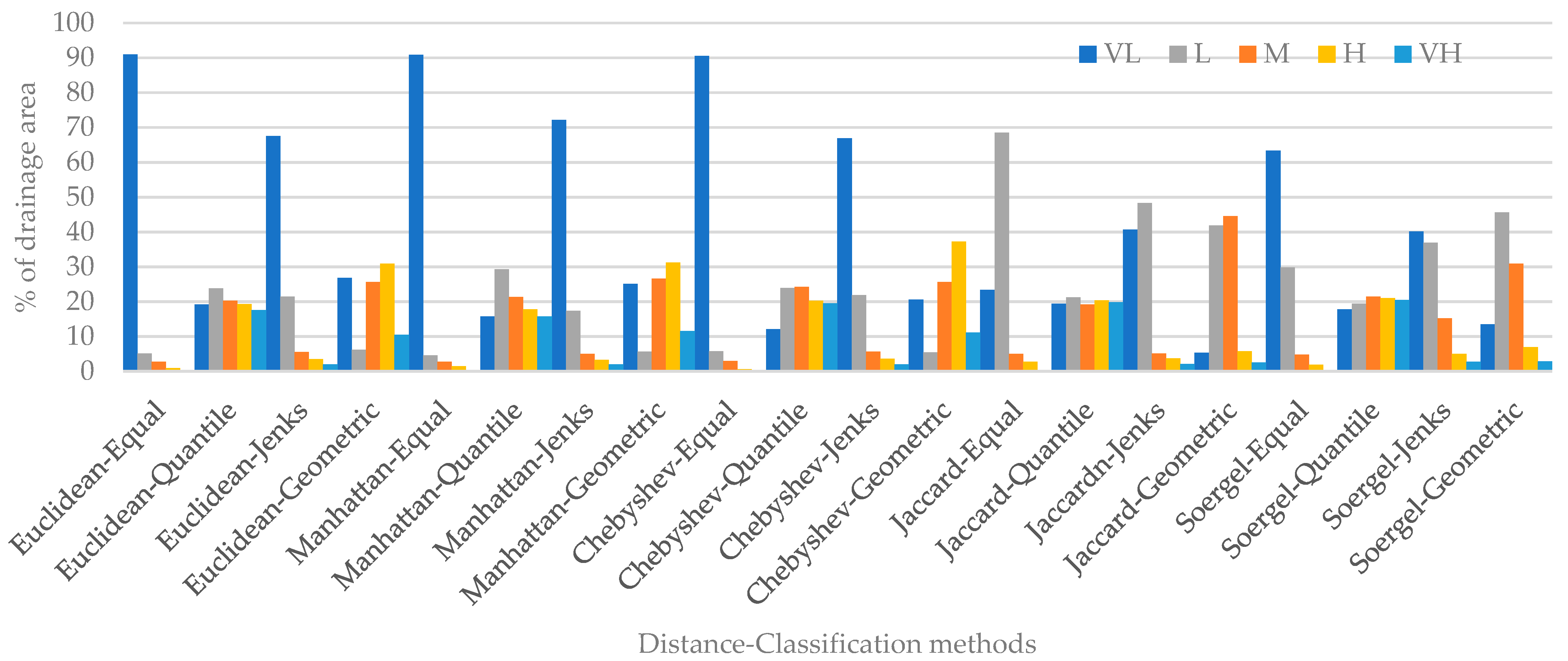


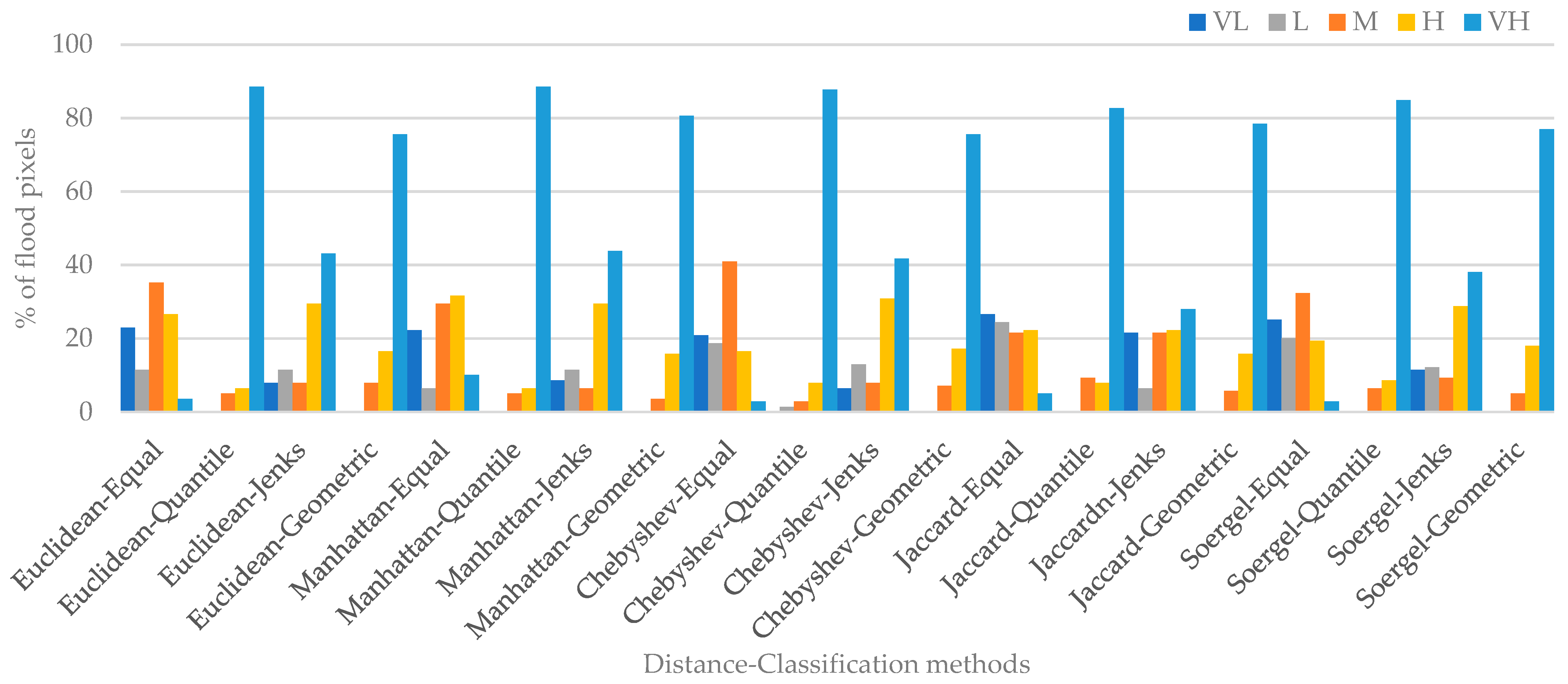
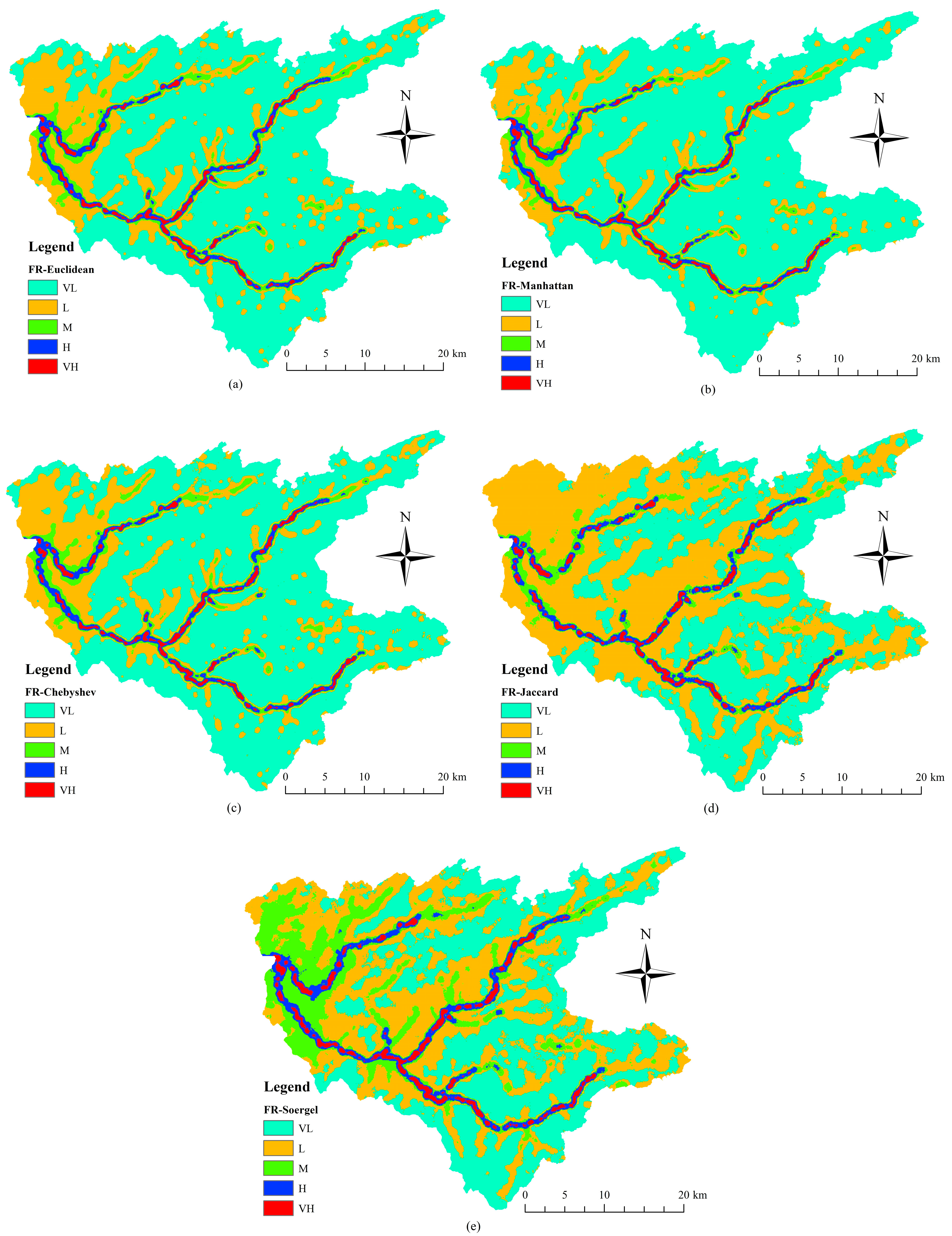
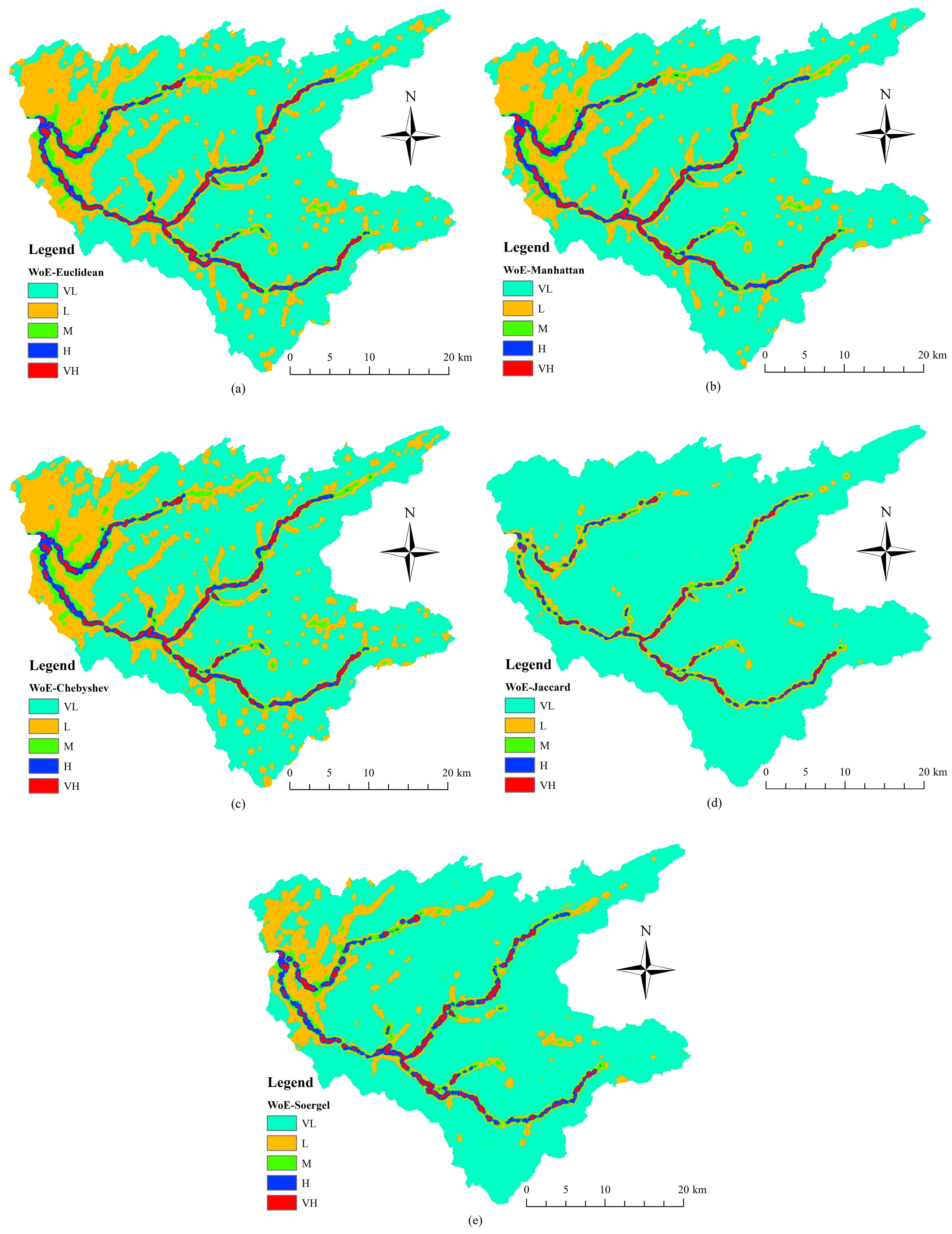
| Factors | Class No. | FR | W | Wj | Factors | Class No. | FR | W | Wj |
|---|---|---|---|---|---|---|---|---|---|
| Elevation (m) | 1 | 3.77 | 10.44 | 0.65 | TWI | 1 | 0 | −0.25 | 10.41 |
| 2 | 1.22 | 1.29 | 2 | 0 | −0.25 | ||||
| 3 | 0 | 1 | 3 | 0 | −0.25 | ||||
| 4 | 0 | 1 | 4 | 0.92 | −0.18 | ||||
| 5 | 0 | 1 | 5 | 54.02 | 15.13 | ||||
| Slope (°) | 1 | 6.38 | 10.17 | 1.21 | SPI | 1 | 0.62 | −36.69 | 89,778.9 |
| 2 | 0.19 | −4.14 | 2 | 1412.00 | 33.50 | ||||
| 3 | 0 | −4.20 | 3 | 1135.58 | 19.30 | ||||
| 4 | 0 | −4.20 | 4 | 1011.57 | 9.71 | ||||
| 5 | 0 | −4.20 | 5 | 0 | −37.00 | ||||
| Aspect | 1 | 18.83 | 15.57 | 1.49 | Curvature | 1 | 0.30 | −2.58 | 0.31 |
| 2 | 0.42 | −2.08 | 2 | 1.35 | 4.42 | ||||
| 3 | 0.76 | −0.75 | 3 | 0 | −2.65 | ||||
| 4 | 0.29 | −2.24 | Soil groups | A | 12.29 | 16.53 | 4.11 | ||
| 5 | 0.67 | −1.31 | G | 0.21 | −6.94 | ||||
| 6 | 0.76 | −0.92 | K | 0.25 | −2.95 | ||||
| 7 | 0.95 | −0.18 | M | 12.19 | 10.31 | ||||
| 8 | 0.73 | −1.02 | N | 0 | −7.00 | ||||
| 9 | 0.79 | −0.89 | P | 0.18 | −2.55 | ||||
| Dd (1/km) | 1 | 0.59 | −2.08 | 0.04 | Distance from river | 1 | 3.32 | 8.36 | 0.59 |
| 2 | 1.56 | 3.20 | 2 | 0.12 | −4.16 | ||||
| 3 | 1.04 | 0.20 | 3 | 0.09 | −3.70 | ||||
| 4 | 0.84 | −0.74 | 4 | 0 | −4.25 | ||||
| 5 | 0.66 | −1.16 | 5 | 0 | −4.25 |
Disclaimer/Publisher’s Note: The statements, opinions and data contained in all publications are solely those of the individual author(s) and contributor(s) and not of MDPI and/or the editor(s). MDPI and/or the editor(s) disclaim responsibility for any injury to people or property resulting from any ideas, methods, instructions or products referred to in the content. |
© 2024 by the authors. Licensee MDPI, Basel, Switzerland. This article is an open access article distributed under the terms and conditions of the Creative Commons Attribution (CC BY) license (https://creativecommons.org/licenses/by/4.0/).
Share and Cite
Akay, H.; Baduna Koçyiğit, M. Investigation of Flood Hazard Susceptibility Using Various Distance Measures in Technique for Order Preference by Similarity to Ideal Solution. Appl. Sci. 2024, 14, 7023. https://doi.org/10.3390/app14167023
Akay H, Baduna Koçyiğit M. Investigation of Flood Hazard Susceptibility Using Various Distance Measures in Technique for Order Preference by Similarity to Ideal Solution. Applied Sciences. 2024; 14(16):7023. https://doi.org/10.3390/app14167023
Chicago/Turabian StyleAkay, Hüseyin, and Müsteyde Baduna Koçyiğit. 2024. "Investigation of Flood Hazard Susceptibility Using Various Distance Measures in Technique for Order Preference by Similarity to Ideal Solution" Applied Sciences 14, no. 16: 7023. https://doi.org/10.3390/app14167023






